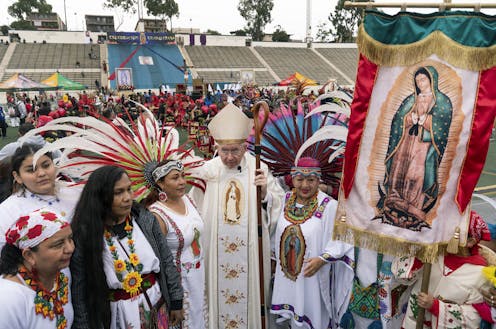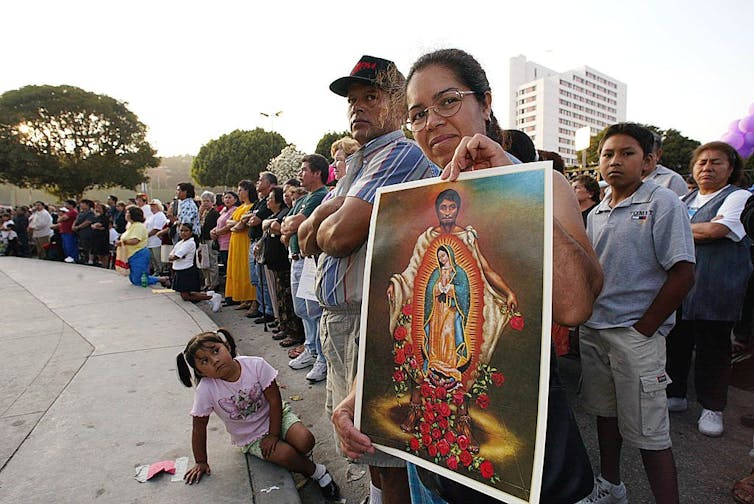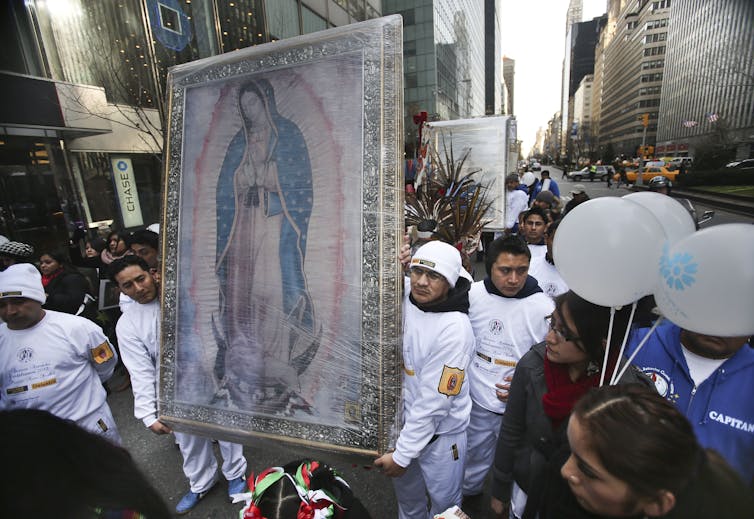Viva Guadalupe! Beyond Mexico, the Indigenous Virgin Mary is a powerful symbol of love and inclusion
The famous apparition of the Virgin Mary has come to symbolize Mexico, but other groups – particularly migrants and Latinos north of the border – also feel a special connection to Guadalupe.

Dec. 12 is a special day for millions of Catholics around the world, especially those of Mexican descent. Known as el Dia de la Virgen Guadalupe, it is a popular feast day that celebrates the Virgin of Guadalupe: a brown-skinned, Indigenous vision of Mary that Catholics believe appeared to a peasant in 1531.
The story of Guadalupe’s appearances is recounted in a text called the Nican Mopohua, which means “Here It Is Told” in Nahuatl, an Aztec language. The Nican Mopohua describes Jesus’ mother appearing multiple times to Juan Diego Cuauhtlatoatzin, an Indigenous convert to Catholicism, about a decade after the Spanish had conquered Aztec Mexico. After her fourth and final apparition to Diego, Catholics believe that her image imprinted onto his cactus-fiber robe, known as a “tilma.”
As a scholar of Catholicism, I have long been fascinated by the adoration of the Virgin Mary. Often seen as a symbol of inclusive love, the Virgin of Guadalupe has become especially beloved by migrants and Latinos in the U.S., who view her as a protector.
Over the past 20 years, research on Guadalupe has brought me to deeply moving shrines in her honor in the United States: candle-filled, flower-laden places, from South Phoenix, Arizona, to Columbus Junction, Iowa, from Catholic parishes to family homes and yards.
Miraculous cloak
According to the original story of Guadalupe, the Virgin provided Juan Diego with Spanish roses – a type not grown in Mexico – to convince Archbishop Juan de Zumárraga that the apparitions were real. After seeing the roses, and the transformation of Juan Diego’s humble cloak into a holy relic, he declared the apparitions miraculous and built a chapel to honor la Virgen.
The original chapel, the Capilla de Indios, where Juan Diego lived for the rest of his life, still stands in Mexico City. It is flanked by a museum, a Carmelite convent, the Old Basilica – built to honor la Virgen – and the modern one, where the famous cloak has hung since 1976.
Millions of people – Catholic and non-Catholic, Latino and non-Latino – have made pilgrimages to the shrine to pray, to give thanks and to pay respects to this Indigenous manifestation of the Virgin. Affectionately called “la Virgencita,” she is depicted as a symbol of motherhood, care and concern for her children.

While some scholars question the historical veracity of the Nican Mopohua, the Catholic Church has approved the story of the apparitions. Pope John Paul II named the Virgin of Guadalupe “Patroness of the Americas” and “Star of the New Evangelization” in 1999, indicating her central role in spreading Catholic Christianity in the Americas.
In 2002, John Paul II canonized Juan Diego as the first Indigenous North American Catholic saint, with his own feast day on Dec. 9.
La Virgen Morena
The official sanctioning of the apparitions certainly has contributed to Guadalupe’s popularity. Yet it is her humble origins and relatability that have made adoration for the Virgin endure.
Specifically, it is la Virgencita’s Indigenous origins – a “morena,” as Spanish speakers refer to a woman with dark hair and dark skin. Unlike other famous apparitions of the Virgin Mary, most of which describe her as looking white and European, la Virgen represents Meso-Americans’ rich heritage, recognizing the dignity of non-European cultures.
As the scholar of religion Lloyd Barba has written, “For centuries now, Guadalupe has represented Mexicans’ mythologized histories of race, peoplehood, and nation.” The folklorist Eric Wolf considered Guadalupe a “master symbol,” something that “enshrines the major hopes and aspirations of an entire society.”
Today, the special connection between Latinos and Guadalupe taps into the vexed, violent history of the U.S.-Mexico borderlands. A colonized people, many Mexicans have long rallied around la Virgen in times of distress and need, and her image has been a unifying symbol during wars and revolutions.
Father Miguel Hidalgo, a leader of the 1810 Mexican War of Independence, paraded banners with la Virgen’s image. So did the revolutionary Emiliano Zapata and his band of reformers during the 1910 Mexican Revolution.
And among many Latinos, whether practicing Catholics or not, she is believed to be a mother who loves her children, no matter what: a woman who stands by them whether they are poor, rich, single, married, queer or straight.

Beloved, both sides of the border
Dec. 12 is a joyful day, with traditional Mexican foods and music.
A large statue of la Virgen is carried through the streets, and “los Matachines” dancers wear gorgeous Indigenous garb as they honor her, marking the day as sacred. Whether you visit Chicago, Phoenix or West Liberty, Iowa, you will find a communitywide celebration of Guadalupe, open to all.
Painted murals of Guadalupe brighten concrete and stuccoed buildings across the U.S., and little home shrines called “altarcitos” feature small statues of la Virgen, Jesus and a panoply of saints, along with candles and photographs of family members, both living and departed.
Indeed, la Guadalupe is a powerful master symbol of a woman who gives hope, love and assurance – especially to those who feel marginalized or oppressed.
Kristy Nabhan-Warren does not work for, consult, own shares in or receive funding from any company or organization that would benefit from this article, and has disclosed no relevant affiliations beyond their academic appointment.
Read These Next
What’s at stake in Trump’s executive order aiming to curb state-level AI regulation
In the absence of comprehensive federal AI regulation, states have stepped in. The Trump administration,…
The Bible says little about Jesus’ childhood – but that didn’t stop medieval Christians from enjoyin
Legends about Jesus’ early years that circulated in medieval Europe often drew on apocryphal texts.
Whether Netflix or Paramount buys Warner Bros., entertainment oligopolies are back – bigger and mor
Hollywood has seen this movie before.





